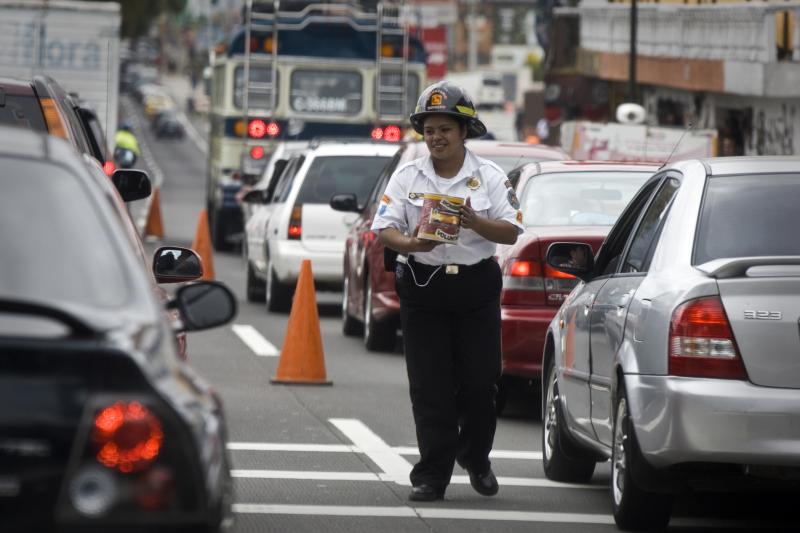

The United Road Safety Fund aims to raise awareness among one billion people by 2030 of need for financing to tackle road deaths in low- and middle-income countries.
Habtamu Zerihun, 38, is father to three daughters, under 12. He used to be a construction worker in Addis Ababa, until he was hit on his way to work.
“A heavy pickup truck passed the curb and smashed into my minibus, as the driver of the truck dozed off due to over-exhaustion. The driver had been using a stimulant drug to stay awake and keep working longer,” he said.
The driver fled the scene and Habtamu was treated in hospital, but the crash left him with disabilities that prevent him from working. It has had severe economic and social consequences for his family.
“The biggest pain for me as father of three daughters is that they stopped going to school due to my inability to pay any more for their school fees, books and uniforms.”
Ethiopia has very high road fatalities--with 26.7 deaths per 100,000 people each year, according to WHO data. High-income countries have an average of 8.3 road traffic deaths per 100,000 people. Death rates from traffic crashes are higher in Africa than anywhere else.
Every 24 seconds at least one person has a life taken away because of a road traffic injury. In 93 percent of the cases, that person lives in a low- or middle-income country.
The United Nations Road Safety Fund (UNRSF)'s new campaign "#moments2live4" encourages everyday road users to reflect on and share those simple moments that too precious to lose to irresponsible road safety behaviour.
With more than 1.3 million deaths worldwide each year and nearly 50 million serious injuries, traffic crashes are the leading cause of death for children and young people between five and 29 years old. It is a global health issue that like in Habtamu’s case lead to losing jobs, and disastrous financial knock on effects. Estimates indicate that road crashes cost low- and middle-income countries 3-5 percent of their gross domestic product.
Having a world where roads are safe for every road user, everywhere is the vision of the UNRSF. It was created as an innovative public-private partnership to help achieve the two Sustainable Development Goal (SDG) targets that address road safety: SDG target 3.6 on halving the number of global road deaths and injuries; and SDG target 11.2 on providing safe, affordable, accessible and sustainable transport systems for all.
With a goal to reach one billion people by 2030, mostly through social media, the campaign will be animated through various national champions in the 24 most populous countries. Each month, three countries will be highlighted.
“This social media campaign will be largely dependent on every citizens’ support to communicate that we are losing millions of lives and livelihoods because of measures which can be avoided, especially if we remind ourselves of our most important moments to live for. We call on every single person to support and share the #moments2live4 campaign,” says Nneka Henry, Head of the UNRSF
UNDP worked with UNRSF to developing on the crowdfunding campaign. The team also joined the second cohort of the Crowdfunding Academy, a joint initiative with the Alternative Finance Lab.
Advocacy for investments in road safety is vital to help mobilize and channel resources to the communities and corners of the world which have the greatest road crash toll.
In Addis Ababa, pedestrians and cyclists represent more than half of road users and about 80 percent of all road victims. Building safe and inclusive walking and cycling infrastructure is crucial.
The project resulted in the adoption of a Non-Motorised Transport Strategy for Ethiopia and Addis Ababa, and a five-year implementation plan for 69 cities and towns with harmonized street design guidelines and investment in safer facilities for walking and cycling taking into account the needs of all its residents, including women, children, and persons with disabilities.
Championed by Ethiopia’s Minister of Transport, Dagmawit Moges, walking and cycling days and ‘placemaking’ events helped to build public support by closing streets for motorized transport, promoting a shift to sustainable mobility focusing on the needs of vulnerable road users like Habtamu and so many other men, women, girls and boys.
Ms Moges’ determination and efforts were also strengthened by the outbreak of the COVID-19 pandemic, presenting a unique momentum for walking and cycling in cities: “We learned during the pandemic that having non-motorized transport alternatives and provision of good public transport is not only a matter of demand and supply. It is a tool to shape our health practices,” she says.
"We do not want a world where being safe on the roads is reserved only for a privileged few countries. One of the main objectives of this campaign is to demonstrate that road safety is truly a global development challenge that affects every country and everyone; but that some countries have less available resources to substantially curb road traffic deaths and injuries than others, which not only harms their citizens and tourists but also weakens their health systems and economies," says Olga Algayerova, Executive Secretary of the United Nations Economic Commission for Europe.
The UNRSF’s 25 projects in 30 countries support low- and middle-income countries to implement these preventative measures ranging from speed management to safer used vehicle standards to legislation on traffic rules and use of safety devices to road crash mapping to training urban planners on how to construct roads in a way that children, pedestrians, cyclists, vehicles and public transport users can all safely share the road.
Habtamu says small differences could result in big changes for people like him.
"My dream is to achieve accident-free and safe mobility in Ethiopia through behavioural change of drivers, an efficient system of penalty, and adequate and fitting infrastructure with barriers around curbs,” he says.
Interested in contributing to global road safety? Donate here.
Originally published on UNDP.org